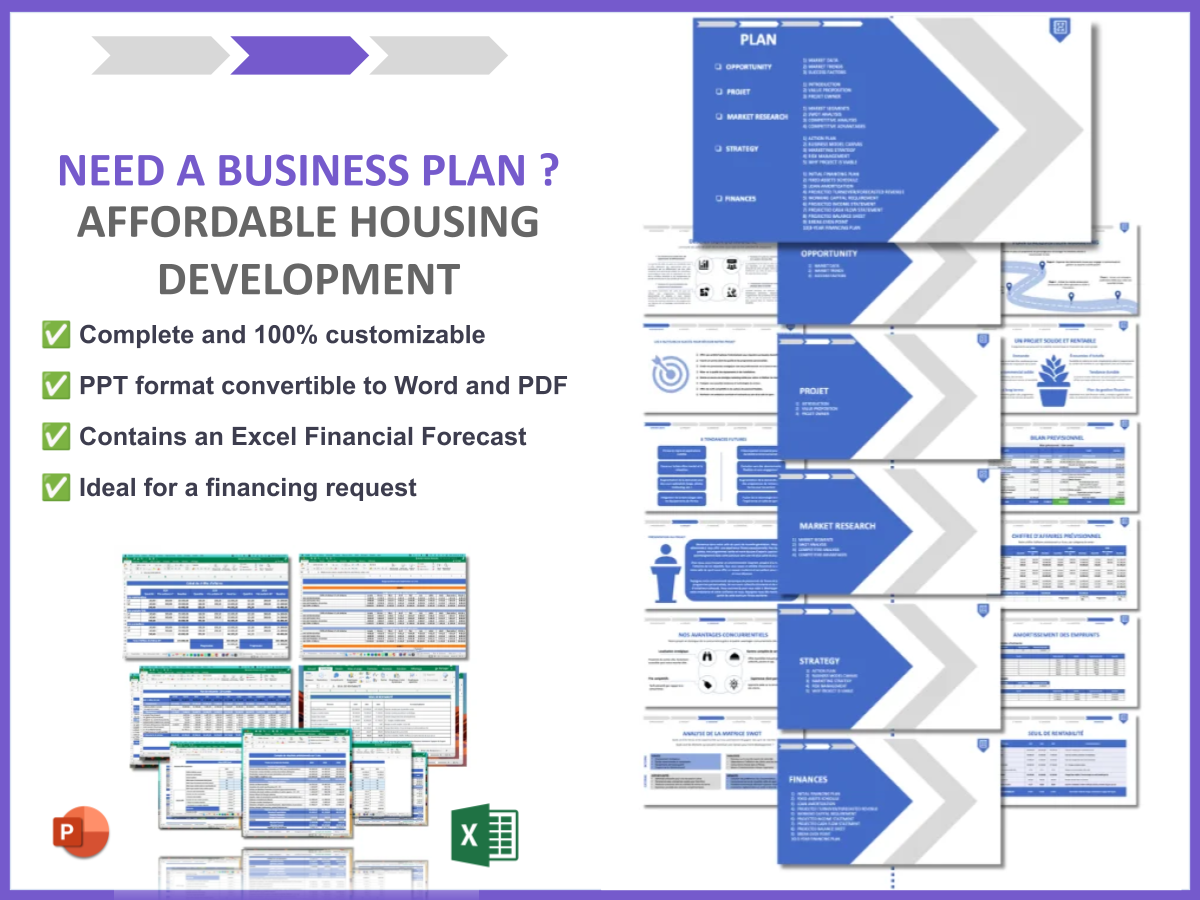Why Should You Have a SWOT Analysis for Affordable Housing Development?
Are you considering an affordable housing development project? You’re not alone! With the growing demand for affordable housing, understanding the landscape through a SWOT analysis can be a game-changer. Did you know that nearly 20 million households in the U.S. are spending more than half their income on housing? This staggering fact highlights the urgent need for strategic planning in affordable housing. A SWOT analysis helps in identifying the strengths, weaknesses, opportunities, and threats associated with your project, paving the way for informed decision-making.
A SWOT analysis is a strategic planning tool used to identify the internal strengths and weaknesses of an organization or project, as well as external opportunities and threats. It allows developers to critically evaluate their initiatives and make adjustments to enhance the success of their housing development projects.
- Understanding the importance of a SWOT analysis in affordable housing.
- Key components of writing a SWOT analysis.
- Detailed examples of SWOT analyses from various affordable housing projects.
- Insights into strengths that contribute to successful developments.
- Common weaknesses faced in affordable housing initiatives.
- Opportunities for growth and innovation in the sector.
- Potential threats that can hinder project success.
- Practical tips for conducting your own SWOT analysis.
- Importance of stakeholder involvement in the analysis process.
- Conclusion and call to action for aspiring developers.
How Do You Write a SWOT Analysis for Affordable Housing Development?
Writing a SWOT analysis involves gathering data, consulting with stakeholders, and structuring your findings effectively. Here’s how to break it down:
Strengths
Strengths are internal factors that give your project an advantage. For instance, a strong community support base can significantly enhance project viability. Access to government grants and funding can also be a major strength, providing necessary financial support for development. Experienced project management teams bring valuable expertise to the table, ensuring efficient execution and risk management. Additionally, a strategic location in a growing area can boost demand for housing, making the project more attractive to investors.
Weaknesses
Weaknesses are internal factors that can hinder your project. Limited funding sources can pose a significant challenge for affordable housing projects, leading to potential delays or cutbacks. Regulatory hurdles often slow down development processes, increasing costs and complexity. A lack of awareness or interest from potential residents can result in low occupancy rates, and dependence on external contractors may lead to inconsistent quality and project delays.
Opportunities
Opportunities are external factors that can enhance your project’s success. Growing awareness of housing issues provides a ripe opportunity for innovative solutions and partnerships. Technological advancements can lead to cost-effective building methods, enhancing affordability. Increasing demand for sustainable housing options can attract eco-conscious investors, while collaborations with non-profits and community organizations can expand funding and support networks.
Threats
Threats are external factors that can negatively impact your project. Economic downturns can reduce funding and demand for affordable housing. Changes in government policies may impact funding and regulations affecting housing projects. Competition from private developers can make it challenging to secure land and resources, and public opposition or community resistance can hinder project approval and progress.
SWOT Example N°1 for Affordable Housing Development
This example illustrates a successful affordable housing project in an urban setting.
| SWOT | Analysis |
|---|---|
| Strengths | Strong community support and access to state funding. |
| Weaknesses | Limited space and high land costs. |
| Opportunities | Rising demand for affordable housing in urban areas. |
| Threats | Economic instability and changing zoning laws. |
- Strong community backing.
- Access to state funding.
- Rising demand for affordable units.
- Economic uncertainties.
- This example highlights the critical role of community support in ensuring project success. Without it, even the best plans can falter.
SWOT Example N°2 for Affordable Housing Development
An analysis of a suburban affordable housing initiative reveals key insights.
| SWOT | Analysis |
|---|---|
| Strengths | Lower land costs and a supportive local government. |
| Weaknesses | Limited public transportation options. |
| Opportunities | Potential for tax incentives for developers. |
| Threats | Resistance from existing residents. |
- Affordable land prices.
- Supportive local policies.
- Tax incentives for development.
- Community pushback.
- This case underscores the importance of understanding community dynamics in suburban settings.
SWOT Example N°3 for Affordable Housing Development
An inner-city project faced unique challenges and opportunities.
| SWOT | Analysis |
|---|---|
| Strengths | Proximity to amenities and services. |
| Weaknesses | High crime rates affecting desirability. |
| Opportunities | Grants available for urban renewal projects. |
| Threats | Gentrification leading to displacement. |
- Close to essential services.
- Grants for urban projects.
- High crime impacting appeal.
- Risks of gentrification.
- This example illustrates the delicate balance between revitalization and displacement in urban settings.
SWOT Example N°4 for Affordable Housing Development
A rural affordable housing development showcases different dynamics.
| SWOT | Analysis |
|---|---|
| Strengths | Abundant land availability and community engagement. |
| Weaknesses | Limited access to services and infrastructure. |
| Opportunities | Potential for eco-friendly building practices. |
| Threats | Declining population in rural areas. |
- Lots of available land.
- Strong community involvement.
- Eco-friendly building potential.
- Population decline challenges.
- This case reveals how rural developments must adapt to unique local circumstances.
SWOT Example N°5 for Affordable Housing Development
An analysis of a mixed-use development that includes affordable housing.
| SWOT | Analysis |
|---|---|
| Strengths | Integrated living and commercial spaces. |
| Weaknesses | Complexity in managing diverse stakeholders. |
| Opportunities | Increased foot traffic from commercial spaces. |
| Threats | Market fluctuations affecting commercial viability. |
- Combined residential and commercial benefits.
- Increased local traffic.
- Stakeholder management complexities.
- Vulnerability to market changes.
- This example highlights the potential and challenges of mixed-use developments.
SWOT Example N°6 for Affordable Housing Development
An affordable housing initiative focused on sustainability.
| SWOT | Analysis |
|---|---|
| Strengths | Use of sustainable materials and designs. |
| Weaknesses | Higher initial costs for eco-friendly building. |
| Opportunities | Growing market for green housing. |
| Threats | Potential for regulatory changes impacting sustainability practices. |
- Eco-friendly materials.
- Higher upfront costs.
- Demand for green housing.
- Regulatory risks.
- This case shows how sustainability can be both a strength and a challenge.
SWOT Example N°7 for Affordable Housing Development
An analysis of a project utilizing innovative financing models.
| SWOT | Analysis |
|---|---|
| Strengths | Creative financing solutions attracting investors. |
| Weaknesses | Complexity of financing arrangements. |
| Opportunities | Potential for scaling innovative models. |
| Threats | Market acceptance of new financing models. |
- Innovative financing attracting investment.
- Complexity of financing models.
- Scaling potential.
- Acceptance risks.
- This example emphasizes the importance of financial innovation in affordable housing.
SWOT Example N°8 for Affordable Housing Development
An analysis of a project focused on accessibility.
| SWOT | Analysis |
|---|---|
| Strengths | Inclusive design features for accessibility. |
| Weaknesses | Higher costs associated with specialized construction. |
| Opportunities | Growing awareness of disability rights in housing. |
| Threats | Competition from standard developments. |
- Accessible design features.
- Increased construction costs.
- Awareness of disability rights.
- Competition risks.
- This case illustrates how focusing on accessibility can create unique challenges and opportunities.
SWOT Example N°9 for Affordable Housing Development
A case study on a community-led affordable housing initiative.
| SWOT | Analysis |
|---|---|
| Strengths | Strong community leadership and engagement. |
| Weaknesses | Limited access to funding. |
| Opportunities | Increased community support for local initiatives. |
| Threats | Resistance from outside developers. |
- Community leadership.
- Funding challenges.
- Local support for initiatives.
- Resistance risks.
- This example highlights the power of community involvement in affordable housing.
SWOT Example N°10 for Affordable Housing Development
An analysis of a project integrating technology in housing.
| SWOT | Analysis |
|---|---|
| Strengths | Use of smart technology for energy efficiency. |
| Weaknesses | Higher costs for tech integration. |
| Opportunities | Growing interest in tech-savvy housing solutions. |
| Threats | Rapid tech changes could outdate systems. |
- Energy-efficient technologies.
- Integration costs.
- Demand for tech-savvy homes.
- Technology risks.
- This case shows how technology can enhance housing but also poses risks.
Conclusion
Conducting a SWOT analysis is crucial for successful affordable housing development. It not only helps identify strengths and weaknesses but also uncovers opportunities and threats that can significantly impact project outcomes. If you’re planning an affordable housing initiative, take the time to conduct a thorough SWOT analysis. It’s an investment in the future success of your project.
For those looking to dive deeper into the planning process, consider checking out this business plan template for Affordable Housing Development. It provides a structured approach to help you lay a solid foundation for your project.
Additionally, you might find these articles helpful:
- How to Create an Affordable Housing Development?
- How to Kickstart an Affordable Housing Development Marketing Plan? With Example
Frequently Asked Questions
What is a SWOT analysis?
A SWOT analysis is a strategic tool that evaluates the Strengths, Weaknesses, Opportunities, and Threats of a project or organization.
Why is a SWOT analysis important for affordable housing?
This analysis is vital as it helps identify key factors that can influence the success or failure of an affordable housing project, guiding effective decision-making and planning.
What are common strengths in affordable housing projects?
Typical strengths include community support, access to funding, and the expertise of experienced management teams.
What weaknesses should be considered?
Common weaknesses may involve limited funding, regulatory challenges, and lack of awareness among potential residents.
What opportunities exist in affordable housing?
Opportunities include technological advancements, tax incentives for developers, and increasing demand for sustainable housing options.
What threats should developers be aware of?
Threats can include economic downturns, changes in government policies, and competition from private developers.
How can community engagement impact a SWOT analysis?
Engaging the community can strengthen your project by enhancing support while helping to mitigate weaknesses and threats.
What role do stakeholders play in a SWOT analysis?
Stakeholders provide valuable insights that inform the SWOT analysis, ensuring a comprehensive understanding of the project’s environment.
How often should a SWOT analysis be conducted?
It’s advisable to perform a SWOT analysis periodically, especially before significant project phases or when external conditions change.
Can a SWOT analysis be applied to other sectors?
Yes, a SWOT analysis is a versatile tool applicable in various fields, including business, healthcare, and education.
What are the best practices for conducting a SWOT analysis?
Best practices include gathering input from diverse stakeholders, using data-driven insights, and regularly reviewing and updating the analysis to reflect current conditions.







